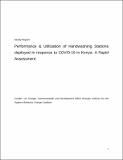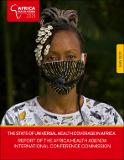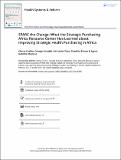Performance & Utilization of Handwashing Stations deployed in response to COVID-19 in Kenya:
Publication Date
2021views
downloads
Metadata
Show full item record
Abstract/
Handwashing, although a simple task, is lifesaving and adherence to proper hand hygiene has been strongly linked to prevention of gastrointestinal infections, respiratory infection, influenza, healthcare-associated infections, and coronavirus. Since the onset of COVID-19, governments and stakeholders have made huge investments on handwashing infrastructure through fragmented and uncoordinated efforts. There is however limited evidence on the functionality, use and usability, and operation and maintanance of HWS deployed in public setting and rapidly deployed at such scale. In Kenya, the National Business Compact on Coronavirus (NBCC) distributed 5311 handwashing stations (HWS) to 46 counties between April and August 2020. The HWS were deployed to targeted hotspots mapped by the Ministry of Health. Each facility was allocated a paid or unpaid caretaker (depending on the distributing partner and resources available) to ensure the facility remained functional and equipped with soap and water. This mixed-methods, observational study examined the functionality, use, usability, and appropriate messaging of the deployed HWS by partners of NBCC and and correlated with the knowledge and attitudes of users and facility managers. The study also aimed to unveil the experiences, challenges faced, practical options and opportunities presented by the implementation of this program and deployment that could inform improvements in existing public HWS; planning and selecting the most suitable options; as well as inform strategies for future roll- out for public settings in different contexts. Systematic sampling was used to select a total of 430 HWS across five selected counties with unannounced spot checks, 30-minute structured observation of use, and user available caretakers and a sample of users were surveyed. Topics of interest were further explored through in-depth interviews with key informants and a subsample of caretakers, and during focus group discussions with community members. Spot checks were conducted at 316 (73.5%) of the selected HWS, during which 304 caretakers both paid and unpaid were interviewed. The remaining sample of HWS were missing due to various reasons including: caretaker was away, HWS and Caretaker could not traced, business and caretakers had relocated, and some of the HWS had been stolen. Ninety-seven percent of surveyed HWS had water, 88.9% had soap available for use (25% bar soap, 61.7% liquid soap and 1.6% soapy water) and 92.1% of the HWS taps were working with no leaks. However, 49.1% of the installed hand washing stations could not be physically reached by a person in a wheelchair. Only 158 (52.0%) of caretakers had received training on management and maintenance of HWS. Training was more commonly received by paid caretakers than by unpaid caretakers (71.6% vs 43.1%, P<0.001). HWS attended by paid caretakers were more commonly functional than those attended by unpaid caretakers with respect to soap availability (95.9% vs 78.4%, P=0.001). In conclusion, this rapid assessment demonstrated that the handwashing stations distributed by NBCC partners in response to COVID-19 in Kenya were largely functional, but of note was that a quarter of HWS were not where they were supposed to be and therefore NOT functional. A positive note is that most of the users washed their hands independently with soap and water but some improvements, e.g. heights of the tap and terrains of installation points, need to be made. There are however gaps and barriers related to access and use and recommendations include improving ease of dispensing water & soap (contact free); improving daily operation and maintenance, including replenishment of consumables; and increasing the numbers and distribution of handwashing stations, with proper coordination. Critical questions remain: will these HWS remain functional, and will they translate to sustained improvements in handwashing behaviour?
Collections
- General - GEN [367]
Related items
Showing items related by title, author, creator and subject.
-
HMD 422: Health Systems in Africa
Department of Health Systems Management and Development, Amref International University (Amref International University, 2021-07-29) -
The State of Universal Health Coverage in Africa – Report of The Africa Health Agenda International Conference Commission
Commissioners, AHIC; Commission Technical Advisors, AHAIC; Commission Secretariat and Research Assistants; Edwine, Barasa; Hakiba:, Solange; Pokuaa, Fenny Ama; Francis, Omaswa; Shabir, Moosa; Karim, Bendhaou; Shakira, Choonara; Eugene, Foyeth; Rindra, Ralidera Onisoa; Gerald, Manthalu; Oluwafunmilola, Dare; Jonathan, Dangana; Waruguru, Wanjau; Rispah, Walumbe; Dennis, Waithaka; Robinson, Oyando; Evans, Otieku; Lizah, Nyawira (Amref Health Africa, 6/9/2021)PREFACE: The AHAIC (Africa Health Agenda International Conference) Commission for the State of UHC in Africa was established by Amref Health Africa in November 2020 with the support of Bill and Melinda Gates foundation, as ... -
SPARC the Change: What the Strategic Purchasing Africa Resource Center Has Learned about Improving Strategic Health Purchasing in Africa
Cashin, Cheryl; Kimathi, George; Otoo, Nathaniel; Bloom, Danielle; Munyua, Agnes Gatome (Taylor & Francis Group - HEALTH SYSTEMS & REFORM, 2022-12-06)Embodied in the goals of universal health coverage (UHC) are societal norms about ethics, equity, solidarity, and social justice. As African countries work toward UHC, it is important for their governments to use all ...



